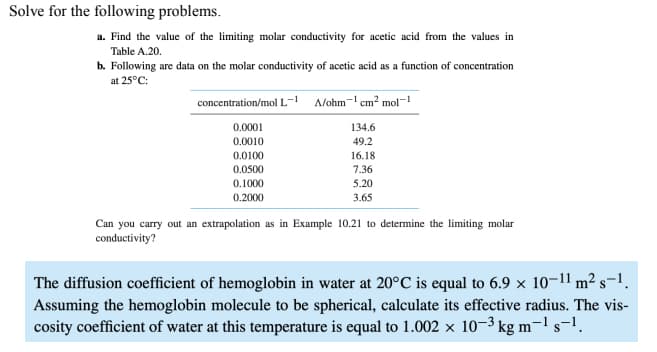The diffusion coefficient of hemoglobin in water at 20°C is equal to 6.9 x 10-11 m2 s-1. Assuming the hemoglobin molecule to be spherical, calculate its effective radius. The vis- cosity coefficient of water at this temperature is equal to 1.002 x 10-3 kg m-1 s-1.
The diffusion coefficient of hemoglobin in water at 20°C is equal to 6.9 x 10-11 m2 s-1. Assuming the hemoglobin molecule to be spherical, calculate its effective radius. The vis- cosity coefficient of water at this temperature is equal to 1.002 x 10-3 kg m-1 s-1.
Chemistry
10th Edition
ISBN:9781305957404
Author:Steven S. Zumdahl, Susan A. Zumdahl, Donald J. DeCoste
Publisher:Steven S. Zumdahl, Susan A. Zumdahl, Donald J. DeCoste
Chapter1: Chemical Foundations
Section: Chapter Questions
Problem 1RQ: Define and explain the differences between the following terms. a. law and theory b. theory and...
Related questions
Question

Transcribed Image Text:Solve for the following problems.
a. Find the value of the limiting molar conductivity for acetic acid from the values in
Table A.20.
b. Following are data on the molar conductivity of acetic acid as a function of concentration
at 25°C:
concentration/mol L- Alohm-' cm? mol-
0.0001
134.6
0.0010
49.2
0.0100
16.18
0.0500
7.36
0.1000
5.20
0.2000
3.65
Can you carry out an extrapolation as in Example 10.21 to determine the limiting molar
conductivity?
The diffusion coefficient of hemoglobin in water at 20°C is equal to 6.9 × 10–1l m² s-1.
Assuming the hemoglobin molecule to be spherical, calculate its effective radius. The vis-
cosity coefficient of water at this temperature is equal to 1.002 × 10–3 kg m-l s-1.
Expert Solution
This question has been solved!
Explore an expertly crafted, step-by-step solution for a thorough understanding of key concepts.
This is a popular solution!
Trending now
This is a popular solution!
Step by step
Solved in 3 steps

Knowledge Booster
Learn more about
Need a deep-dive on the concept behind this application? Look no further. Learn more about this topic, chemistry and related others by exploring similar questions and additional content below.Recommended textbooks for you

Chemistry
Chemistry
ISBN:
9781305957404
Author:
Steven S. Zumdahl, Susan A. Zumdahl, Donald J. DeCoste
Publisher:
Cengage Learning

Chemistry
Chemistry
ISBN:
9781259911156
Author:
Raymond Chang Dr., Jason Overby Professor
Publisher:
McGraw-Hill Education

Principles of Instrumental Analysis
Chemistry
ISBN:
9781305577213
Author:
Douglas A. Skoog, F. James Holler, Stanley R. Crouch
Publisher:
Cengage Learning

Chemistry
Chemistry
ISBN:
9781305957404
Author:
Steven S. Zumdahl, Susan A. Zumdahl, Donald J. DeCoste
Publisher:
Cengage Learning

Chemistry
Chemistry
ISBN:
9781259911156
Author:
Raymond Chang Dr., Jason Overby Professor
Publisher:
McGraw-Hill Education

Principles of Instrumental Analysis
Chemistry
ISBN:
9781305577213
Author:
Douglas A. Skoog, F. James Holler, Stanley R. Crouch
Publisher:
Cengage Learning

Organic Chemistry
Chemistry
ISBN:
9780078021558
Author:
Janice Gorzynski Smith Dr.
Publisher:
McGraw-Hill Education

Chemistry: Principles and Reactions
Chemistry
ISBN:
9781305079373
Author:
William L. Masterton, Cecile N. Hurley
Publisher:
Cengage Learning

Elementary Principles of Chemical Processes, Bind…
Chemistry
ISBN:
9781118431221
Author:
Richard M. Felder, Ronald W. Rousseau, Lisa G. Bullard
Publisher:
WILEY